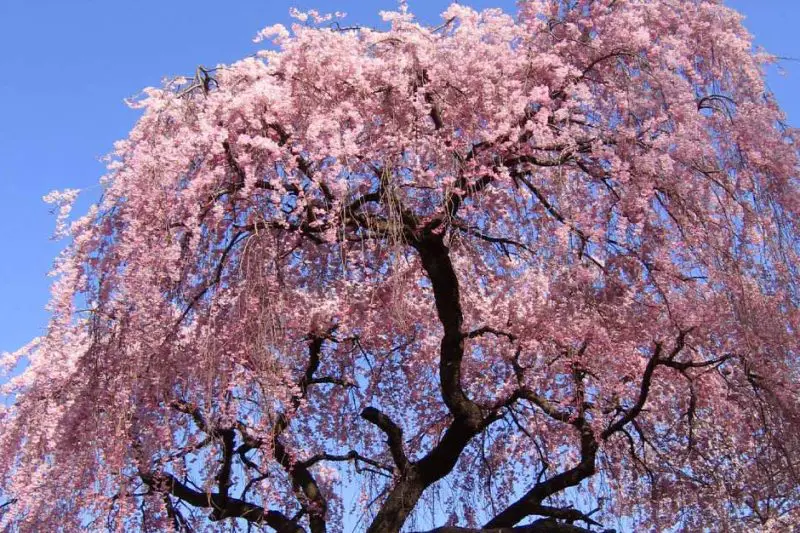Pink weeping cherry trees are a captivating addition to any garden, known for their enchanting bright pink blooms and graceful, arching branches. These trees not only bring a touch of fairy-tale beauty to your landscape but also offer seasonal interest with their vibrant spring flowers and colorful fall foliage.
Whether you’re looking to enhance your garden’s aesthetic or create a stunning focal point, pink weeping cherry trees are an excellent choice.
Pink Weeping Cherry Tree Overview

The pink weeping cherry tree (Prunus subhirtella ‘Pendula’ or Prunus serrulata ‘Kiku-shidare-zakura’) truly has fairy-tale beauty with its bright pink blossoms and graceful weeping appearance! This tree can grow easily in most USDA climate zones. Its scientific name is Prunus subhirtella var. pendula. When mature, the tree can reach a height and width of 20–30 feet. With a moderate growth rate, it should be planted in full sun to partial shade in loamy, fertile, well-draining soil.
The tree requires 2–3 inches of water per week during the growing season. Fertilization should be done in early spring before the tree blooms. The tree typically blooms in spring with light pink flowers, and its leaves turn bright yellow in the fall.
Characteristics of the pink weeping cherry tree
Overall Look
Though not very large, a pink weeping cherry tree adds a splash of color with its profusion of blossoms. Its medium-length branches give it a weeping effect as they arch downward and outward.
Seasonal Hue
The tree will be dormant throughout the winter, showcasing its arching limbs and silver/gray bark. When the blossoms bloom in the spring, the tree becomes a vibrant pink sight. The greatest intrigue and beauty are found during this season. After around two weeks, the pink flowers will give way to lush green foliage. The leaves will turn a vivid yellow before falling to the ground when the temperatures start to drop once more.
Mature Size & Growth Rate
After 15 to 20 years, the pink weeping cherry tree will achieve its full size due to its moderate growth rate. They grow to be around 20 feet tall and wide on average, reaching a height equal to its width.
Blooms
As soon as the snow melts and the weather warms up in the early spring, weeping cherry trees are renowned for their breathtaking blossoms. The flowers will appear in March or April and will have a mild, powdery, floral aroma that will last for one to two weeks.
Autumnal Leaves
The rich green foliage will start to change to a vivid golden hue as the temperatures drop and fall arrives, eventually dropping for the winter. You’re in for a treat in most seasons, with beautiful pink blooms in the spring, green foliage in the summer, and yellow leaves in the fall.
Well-liked Types
While a pink weeping cherry tree is beautiful, there are a few popular varieties that will cater to your specific desires. The Weeping Pink Infusion tree is a stunning choice that is new to the scene and comes with superior disease resistance. Additional popular varieties include the Weeping Yoshino, known for its elegant form and prolific blooms, the Pink Snow Showers, which offers a cascade of delicate pink flowers, and the Pink Cascade, renowned for its vibrant pink blossoms and graceful appearance.
Lifespan Estimate
A pink weeping cherry tree has a 30- to 40-year lifespan, yet it doesn’t survive forever. Despite their hardiness, these trees are susceptible to numerous common pests and illnesses. They can flourish and enhance the beauty of your garden for many years with the right upkeep and care.
Pink Weeping Cherry Tree Care and Growing Guide
The Pink Weeping Cherry Tree is a beautiful ornamental tree known for its cascading branches and vibrant pink blossoms. Here’s a comprehensive guide to help you care for and grow this stunning tree.
Planting Location
When selecting a planting location for a pink weeping cherry tree, ensure it receives full sun to partial shade, with at least 6 hours of direct sunlight per day being ideal. The soil should be well-draining and loamy, with a pH range of 6.0 to 7.5. Avoid planting in heavy clay or overly sandy soils. Additionally, provide sufficient space for the tree to grow to its mature size, which is typically 20–30 feet in both height and spread. This will allow the tree to thrive and display its full beauty.
Planting
For optimal results, plant your pink weeping cherry tree in early spring or fall when the weather is mild. Prepare a hole that is twice as wide and slightly deeper than the root ball. Place the tree in the hole with the top of the root ball level with or slightly above the ground. Backfill the hole with soil, gently tamping it down to eliminate air pockets. After planting, water thoroughly to help settle the soil around the roots. This will ensure your tree establishes well and grows healthily.
Watering
For young pink weeping cherry trees, water regularly during the first year to establish roots, keeping the soil consistently moist but not waterlogged. For established trees, water during dry periods, ensuring deep watering once a week rather than frequent, shallow watering. This method encourages deep root growth and helps maintain the tree’s health and vigor.
Mulching
Mulching serves several important purposes: it helps retain soil moisture, regulates soil temperature, and reduces weed competition. For pink weeping cherry trees, use organic mulch such as wood chips or bark. Apply a 2-3 inch layer around the base of the tree, ensuring the mulch is kept a few inches away from the trunk to prevent rot. This practice will support the tree’s health and growth.
Fertilizing
For optimal growth, fertilize your pink weeping cherry tree in early spring before new growth starts and again in early summer. Use a balanced, slow-release fertilizer, such as a 10-10-10 formulation. Follow the manufacturer’s instructions for the correct amount and method of application to ensure the tree receives the necessary nutrients without the risk of over-fertilizing. This will promote healthy growth and vibrant blooms.
Pruning
Prune your pink weeping cherry tree in late winter to early spring before new growth begins. Remove any dead, damaged, or diseased branches to maintain the tree’s health. Thin out crowded areas to improve air circulation and light penetration. To preserve the tree’s graceful weeping shape, selectively cut back branches to a lateral bud or branch. Proper pruning will enhance the tree’s beauty and promote vigorous growth.
Pest and Disease Management
To keep your pink weeping cherry tree healthy, be vigilant about pest and disease management. Common pests include aphids, scale insects, and caterpillars, which can be controlled using insecticidal soap or horticultural oil if infestations occur. The tree is also susceptible to diseases such as cherry leaf spot, powdery mildew, and cankers. Ensure good air circulation around the tree and avoid overhead watering to reduce the risk of these diseases. Regularly inspect the tree for any signs of pests or diseases and treat them promptly to maintain its health and beauty.
Winter Care
To protect your pink weeping cherry tree during winter, especially if it is young, consider using a burlap wrap to shield it from harsh winds and frost. Before the ground freezes, water the tree thoroughly to ensure it is well-hydrated as it enters the winter season. These steps will help the tree withstand cold temperatures and emerge healthy in the spring.
General Tips
When caring for your pink weeping cherry tree, staking young trees can provide essential support until they establish a strong root system. Regularly monitor the tree’s health and promptly address any issues that arise. For a stunning seasonal display, consider planting the tree alongside other spring-blooming plants. These practices will ensure your tree thrives and enhance your garden’s beauty.






